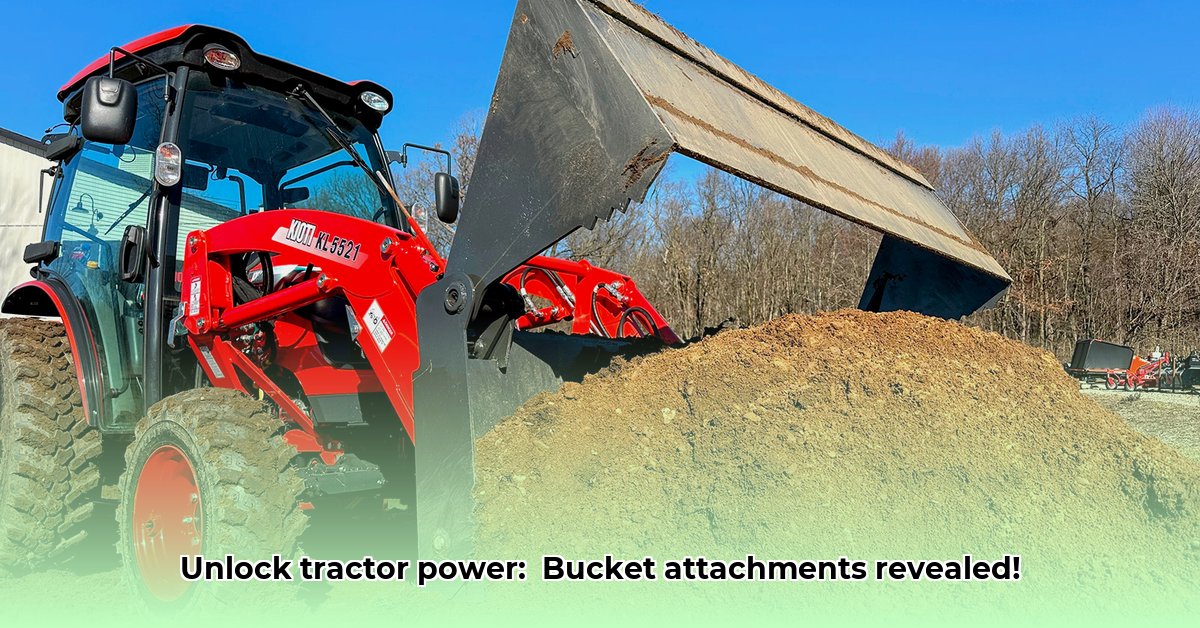
Want to maximize your compact tractor's capabilities? The key lies in its attachments! This guide provides a practical, step-by-step approach to selecting, installing, operating, and maintaining various compact tractor bucket attachments. Whether you're landscaping, clearing land, or tackling snow removal, we'll equip you with the knowledge to choose the right tools and use them safely and efficiently. For even more information, check out this helpful resource on tractor attachments.
Types of Compact Tractor Bucket Attachments
Think of your compact tractor as a versatile platform; these attachments are the tools that transform it. Here's a breakdown of common types:
Buckets: The workhorse of attachments, ideal for digging, scooping, loading, and moving materials like dirt, gravel, and snow. Different sizes and styles cater to various tasks. (Consider capacity and tooth configuration based on material type.)
Forks: Perfect for lifting and transporting palletized materials like hay bales, lumber, and other heavy items. Choose forks with a weight capacity matching your tractor's capabilities. (Pay close attention to safe load limits.)
Box Blades: These attachments excel at land leveling and grading, smoothing out uneven terrain for driveways, gardens, and other areas. (Useful for creating level surfaces and managing topsoil.)
Tillers: Prepare soil for planting with ease. Tillers break up compacted soil, creating a seedbed for efficient planting. (Choose tiller width based on your garden or field size.)
Snow Plows: Winterize your tractor with a snow plow to clear driveways and walkways efficiently. (Blade width and material considerations are crucial for snow removal effectiveness.)
Brush Mowers: Effectively manage overgrown vegetation and clear brush, ideal for land clearing and trail maintenance. (Rotating blades are powerful, but safety is paramount.)
Choosing the Right Attachment: A Practical Guide
Selecting the right attachment is crucial. Consider these factors:
Tractor Capacity: Check your tractor's owner's manual for safe lifting and towing capacities. Exceeding these limits can damage your tractor and compromise safety. (Never exceed the manufacturer's specifications.)
Task Specificity: Match the attachment to the job. A bucket is for digging, forks for moving pallets, and a box blade for leveling. (Select the attachment best suited to the specific task.)
Budget: Attachments range in price. Consider how often you'll use the attachment to justify the investment. (Regular use justifies higher-quality and more durable attachments.)
Frequency of Use: Frequent use necessitates a robust and durable attachment. Occasional use may allow for a more budget-friendly option. (Durability and longevity are key considerations.)
Attachment Installation and Removal: Step-by-Step Instructions
Safety First: Always engage the parking brake before any attachment procedures.
Step 1: Consult the Manuals: Thoroughly review your tractor's and the attachment's owner's manuals. This step is non-negotiable for safety and correct installation.
Step 2: Secure Connections: Carefully align the attachment with the tractor's mounting points. Use the correct pins, bolts, and locking mechanisms, ensuring a secure fit.
Step 3: Pre-Operational Check: Before activating hydraulics, gently move the attachment to confirm secure mounting and proper function.
Step 4: Removal Process: To remove, carefully reverse the installation steps. Double-check that all pins and locking mechanisms are removed before disconnecting.
Operation and Maintenance: Ensuring Optimal Performance
Operation: Read and understand the operating instructions for each attachment. Never exceed the operational limits.
Maintenance: Regularly inspect attachments for wear and tear. Clean mud and debris after each use. Lubricate moving parts as needed.
Storage: Store attachments in a dry place to prevent rust and corrosion.
Troubleshooting Common Problems
Attachment Connection Issues: Check alignment and locking mechanisms. Address any misalignment or malfunctioning parts.
Attachment Slipping: Tighten loose pins or adjust locking mechanisms.
Attachment Malfunctions: If unable to diagnose, contact a qualified mechanic or the manufacturer. Never attempt repairs beyond your skill level.
Safety Precautions: Protecting Yourself and Your Equipment
Always read and follow manuals. This includes both tractor and attachment operating instructions.
Personal Protective Equipment (PPE) is essential: Wear safety glasses, gloves, hearing protection, and steel-toed boots.
Never operate impaired. Maintain full alertness and awareness.
Situational awareness: Pay attention to your surroundings, obstacles, and bystanders.
Pre-use inspections: Inspect your tractor and attachments before each use.
In conclusion, compact tractor bucket attachments significantly enhance your tractor's versatility. By following these guidelines, you can safely and efficiently utilize these tools to boost your productivity and accomplish a wide range of tasks. Remember, safety and proper maintenance are paramount for efficient and safe operation.